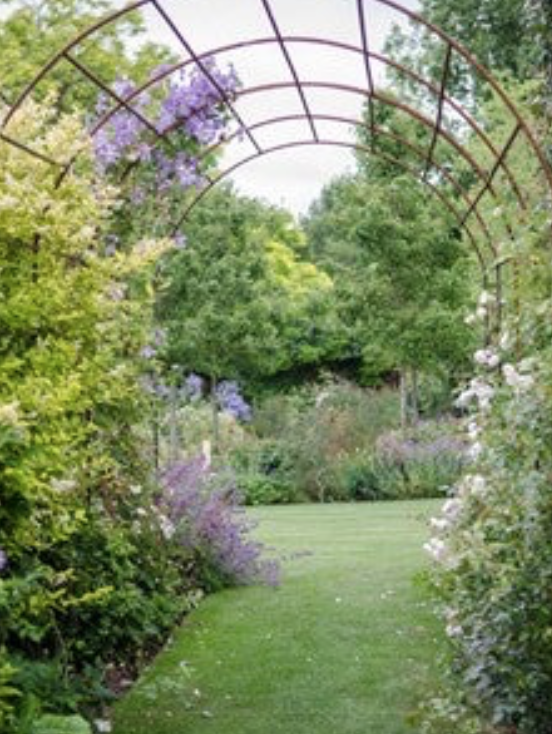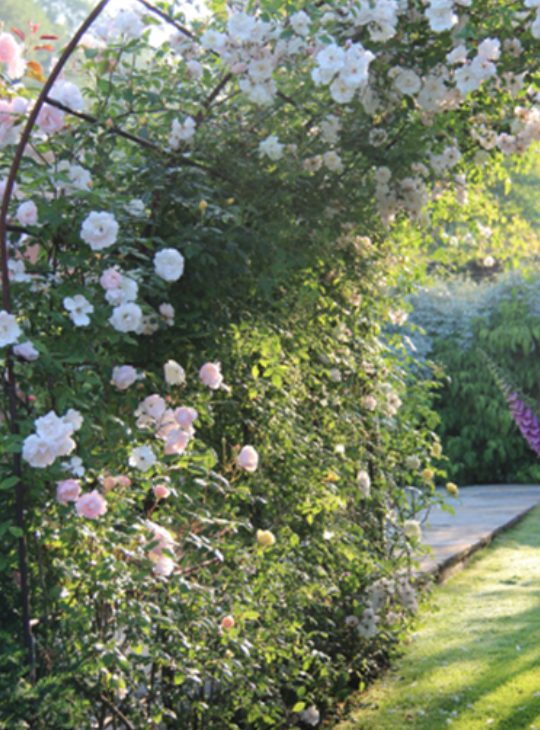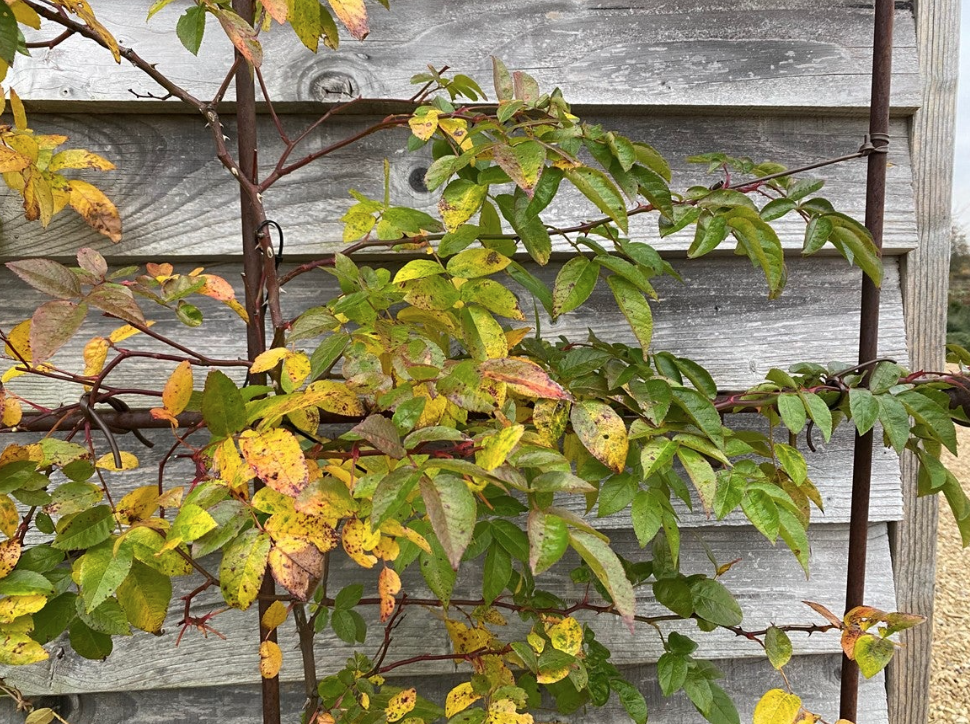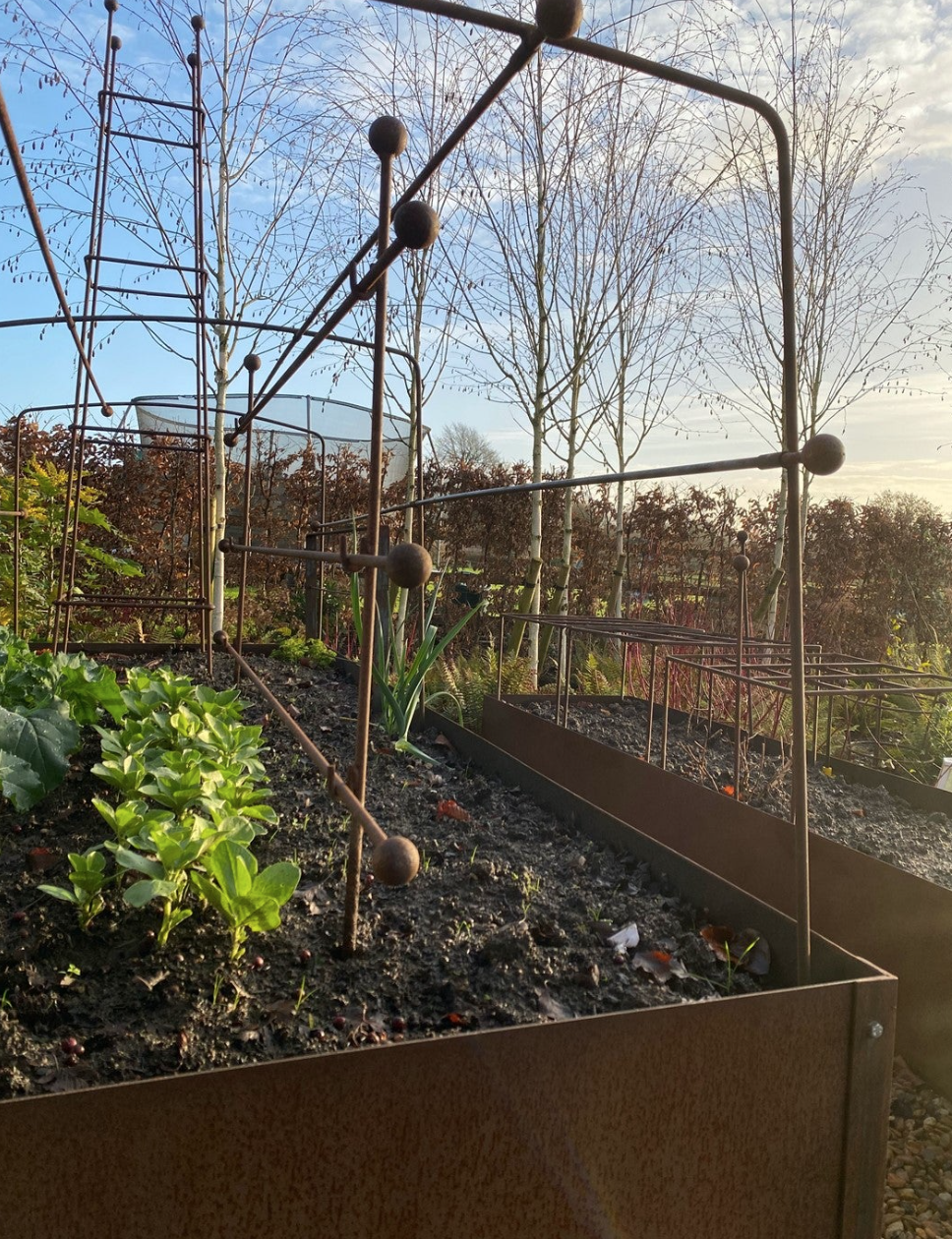
How to plan out your plant supports now, for a stunning border later
SEO Space
Sweet peas reach the top of this 2.5m Cotswold obelisk.

An old-fashioned damask rose will fill this lobster pot by the end of the season.

Rosa ‘Gertrude Jekyll’ climbs happily inside a rose cage.
When we first started our company, some 12 years ago, we used the tag line: ‘Bringing order and tidiness to your garden’. I felt then that the statement was a little imperious but the sentiment still holds good. Every year we look at our favourite borders and think: ‘If only I’d staked that lupin; put a support over that peony; given that rose something to climb up …’!
Now is the time to stock up on stakes, hoops and other types of plant supports for the coming season. We all know the sense of despair when, after a sudden rain storm or wind, those beautiful peonies that only yesterday gave you such pleasure are lying prone. So, get your supports in long before the plants grow and flower – there’s no time like the present!
You can achieve a lot with canes, willow and string as BBC Gardeners’ World demonstrates so beautifully but if you are after a wow factor and a sense of permanence with solid supports that need no assembly, then take a look at what we have to offer. Because we have thought through and tested every design that we sell and because our products are all made for us by small, specialist fabricators in UK, our products are built around the plants’ needs, not what is convenient to mass-produce.
We have something for every type of plant:
Peonies and other perennials prone to flop
Of course, peonies are the classic beauties of the border that flop disastrously at the first rain shower but any herbaceous border plant that needs either containing or supporting will benefit from our wide range of herbaceous supports – and they disappear into the border as the plants grow.
Peony baskets, one ring supports, stakes, lobster pots and obelisks provide support and architectural interest in this long herbaceous border without dominating the plants, which include: nepetas, campanulas, peonies, penstemons, Alchemilla mollis and alstreomerias.
Put in the supports either as you plant or over the winter/spring when there is less growth to cope with – don’t forget that clumps will get larger so make sure the support that you choose is big enough. If the plant is already in full growth, it’s still not too late; lasso the foliage gently and tighten the string until the support can be slipped over it without damaging leaves and flowers; release the string and let the clump relax into its supports.

A tunnel elegantly divides one area of the garden from another.

Roses tumble through an arch.

Rosa ‘Bobby James’ is being trained to a wall trellis.
Clematis, roses, sweet peas and other keen ascenders
Most clematis, vines, many roses and even some vegetables were born to climb. If they can’t find anything to help them upwards, many will stop growing. Use our range of obelisks, singly or in pairs, to support columns of roses, sweet peas, clematis, beans and gourds. Unlike wooden or woven supports, they will never need replacing: we guarantee them for 25 years.
As with all plant supports, the earlier you get them in the better. I normally plant climbing roses in the middle of the obelisk and train them round and up (see our blog post dated 14 December on training climbers); sweet peas and clematis are better planted by the legs of the obelisk and tied in or allowed to twine round the legs as they grow – more vigorous clematis benefit from being trained round the support. Again, an obelisk can be slipped over quite a large plant that has been tied with a series of lassoes.
Creating horticultural architecture
Nearly every garden has a place for an arch: to welcome incomers; define a walkway; frame a seating area or simply to provide a strong support for roses or trained fruit trees. Rosemary Verey’s garden at Barnsley had a breath-taking walk of trained laburnums underplanted with alliums that I always wanted to copy and Rudyard Kipling’s house, Batemans, has a long tunnel planted with Conference pears where, legend has it, he hid himself when he wished to avoid visitors.
Although an arch or tunnel can be positioned nearly anywhere in the garden, most plants will benefit from having their heads in the sun (and their feet in the shade) so chose a position where the plants you put on your arch can get sunshine as they climb to the top of their supports. Plant them in a generous hole with plenty of compost and give them room for the roots to develop; remember to keep all large plants well-watered and fed with a rose or general fertilizer for at least the first season.
Roses are, of course, the perfect plant for an arch or a tunnel: scented, romantic and many are repeat-flowering so they will give a long season and are happy in most soils, although they do prefer heavier soils. However, do chose carefully and check the eventual height of the rose: ‘Kiftsgate’ or ‘Wedding Day’ will overwhelm most supports (‘Kiftsgate’ can climb to 18 meters!) so chose one such as ‘New Dawn’ or ‘The Generous Gardener’ that is less vigorous. Don’t forget to pair your roses with clematis or one of the jasmines, some of which are evergreen.
Unlike wooden or tubular arches, our arches are robust enough to take the weight of plants as they mature in growth over the years. Each arch is welded in a single piece and they are delivered ready to install.

Design sketch for a new steel compost bin.

A raised steel vegetable bed with vegetable cage (Enviromesh will be used to cover the cage frame in Spring); broad bean supports and a square obelisk for runner beans.

Frost crystals sparkle on the grids in the yard.
Disguise or display with a trellis
If winter has laid bare an ugly shed or fence panel, or you want to raise the height of a boundary, why not take back control and invest in a trellis to create an environmentally friendly screen of foliage and flowers? For evergreen coverage on a trellis or arch, Trachelospermum jasminoides or Clematis armandii are ideal, although the clematis needs hard pruning to curb its enthusiasm. Some of the smaller climbing roses will give a stunning summer display. When planting, check the aspect of your wall or shed to ensure that the plants will have optimum conditions for growth and make sure that there is plenty of good soil and that it is not too dry (the soil at the base of a wall or shed is often dry and impoverished).
Our trellis enquiry form will help you answer most of the questions you might have about the site you have in mind. Our trellises are all custom-made to your exact measurements and supplied with spacer brackets that allow air to circulate around the growing plant – perfect for rambling roses, showy wisteria and rampant clematis!
Growing your own
2020 has been the year of the garden. Many of us have realised how dependent we have become on supermarkets for our fresh produce and that there is a huge amount we can grow ourselves to feed our appetite for fresh fruit and vegetables. But where do you start if you’re growing your own for the first time? I will talk about growing vegetables in the coming weeks but there are a few that, once picked and eaten fresh, you will always find room for: top of the list are broad beans – once you’ve eaten them, tiny and sweet and just blanched, you will never buy another; sweet corn, if you can spare a block of space at least 1m x 1m, is another vegetable that begins to lose its flavour as soon as it is picked – the sugars turning to starch; garden peas, picked fresh, will never reach the pot! For economic use of space, it’s hard to beat the climbing beans and the squashes which can be trained over frames or up obelisks and, last but not least, grow your own herbs in the garden or in containers – beware of mint, it’s a thug, but put it in a container and it will be happy.
If you’re planning a self-contained vegetable garden, then finding the right container is the first stop. Most of our designs for steel raised beds and troughs start with a sketch like the one for our new compost bins (below). The sketch is passed to one of our 3 fabricators who will test and modify the design which is produced as a prototype and trialed in our garden before it is offered for sale.
Once you’ve filled your trough with soil and planted your seeds, don’t forget the all-important supports and covers. Our vegetable cages are custom-made to fit your beds; they are 1.2m high which allows for the sides to be raised for picking and can be covered with the fleece or netting of your choice keeping your produce safe from the worst of the weather or flying and browsing pests – we suffer from deer coming in from the fields and the raised beds are essential for keeping out the local rabbit population. Simply add our step-over supports for training apples; broad beans and raspberries or pop in an obelisk or three for climbing beans and cucurbits. If you’re going big this year, put in an espalier support for your fruit trees (a new introduction this year, see 25 January for details) – each one made to order to fit your vegetable garden.
The Supporting Cast
Last, but not least, is our full range of supports for all your herbaceous plants and vegetables – essential for the garden but modestly hidden when the plants are in full growth: stakes, edging hoops and semi-circulars in either our classic 12mm or the more delicate 8mm mild steel. We see them as the corsetry underpinning and supporting the billowing plant life that we are all looking forward to in the coming months.
Browse the complete range at www.muntons.net
Follow us on Pinterest for more advice and inspiration for your English country garden: www.pinterest.co.uk/plantsupports
Follow us on Instagram: www.instagram.com/muntons_plant_supports
